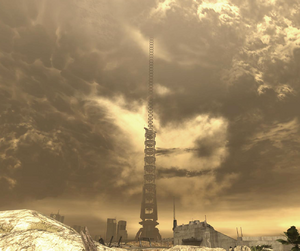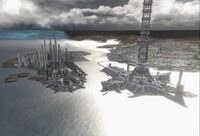Space elevator: Difference between revisions
From Halopedia, the Halo wiki
mNo edit summary |
No edit summary |
||
| Line 5: | Line 5: | ||
'''Space Elevator''' is the term given to an immense structure constructed by [[human]]s which is used to ferry large loads of materials into orbit of a planet. Space elevators generally consist of large structures of [[carbon nanofiber]] which span straight up from the ground, thousands of kilometers high, ending at stations in space. Vehicles using the structure derive power from strands of superconducting material.<ref>[[Halo: Contact Harvest]], pg. 28</ref> | '''Space Elevator''' is the term given to an immense structure constructed by [[human]]s which is used to ferry large loads of materials into orbit of a planet. Space elevators generally consist of large structures of [[carbon nanofiber]] which span straight up from the ground, thousands of kilometers high, ending at stations in space. Vehicles using the structure derive power from strands of superconducting material.<ref>[[Halo: Contact Harvest]], pg. 28</ref> | ||
Space Elevators were once a common construction by the [[UNSC]], both on [[Earth]] and her colonies. There were six on [[Earth]], but only the [[New Mombasa Orbital Elevator]] in [[New Mombasa]]<ref>[[Halo 2]], [[Metropolis (Level)|Metropolis]]</ref>, the [[Centennial Orbital Elevator]] in [[Havana]]<ref>[[Halo: Ghosts of Onyx]], pg. 205</ref> and the [[Quito Space Tether]] in Ecuador<ref>''[[Halo 3]]'' multiplayer map [[Orbital (Level)|Orbital]]</ref> have been named. Before its loss in [[2525]], [[Harvest]] had seven elevators linked to the [[Tiara]], the orbital port of [[Harvest]]<ref>[[Halo: Contact Harvest]], pg. 75</ref>. However, during the events of the [[Human-Covenant War]], most of these elevators were damaged, some seriously, during combat engagements. | Space Elevators were once a common construction by the [[UNSC]], both on [[Earth]] and her colonies. There were six on [[Earth]], but only the [[New Mombasa Orbital Elevator]] in [[New Mombasa]]<ref>[[Halo 2]], [[Metropolis (Level)|Metropolis]]</ref>, the [[Centennial Orbital Elevator]] in [[Havana]]<ref>[[Halo: Ghosts of Onyx]], pg. 205</ref> and the [[Quito Space Tether]] in Ecuador<ref>''[[Halo 3]]'' multiplayer map [[Orbital (Level)|Orbital]]</ref> have been named. Before its loss in [[2525]], [[Harvest]] had seven elevators linked to the [[Tiara]], the orbital port of [[Harvest]]<ref>[[Halo: Contact Harvest]], pg. 75</ref>, though other colonies had as many as nine. However, during the events of the [[Human-Covenant War]], most of these elevators were damaged, some seriously, during combat engagements. | ||
==Description== | ==Description== | ||
Revision as of 23:38, December 20, 2009
Template:Ratings Template:SeeWikipedia
Space Elevator is the term given to an immense structure constructed by humans which is used to ferry large loads of materials into orbit of a planet. Space elevators generally consist of large structures of carbon nanofiber which span straight up from the ground, thousands of kilometers high, ending at stations in space. Vehicles using the structure derive power from strands of superconducting material.[1]
Space Elevators were once a common construction by the UNSC, both on Earth and her colonies. There were six on Earth, but only the New Mombasa Orbital Elevator in New Mombasa[2], the Centennial Orbital Elevator in Havana[3] and the Quito Space Tether in Ecuador[4] have been named. Before its loss in 2525, Harvest had seven elevators linked to the Tiara, the orbital port of Harvest[5], though other colonies had as many as nine. However, during the events of the Human-Covenant War, most of these elevators were damaged, some seriously, during combat engagements.
Description
A space elevator is a structure designed to transport and ferry different materials from a planet's surface into space and onto a platform. The base concept of a Space elevator consists of a cable attached to the surface on the equator and reaching outwards into space. By positioning it so that the total centrifugal force exceeds the total gravity, either by extending the cable or attaching a counterweight, the elevator stays in place geosynchronously. Once moved far enough, climbers are accelerated further by the planet's rotation.
The most common proposal is a tether, usually in the form of a cable or ribbon, that spans from the surface to a point beyond geosynchronous orbit. As the planet rotates, the inertia at the end of the tether counteracts gravity and keeps the tether taut. Vehicles can then climb the tether and escape the planet's gravity without the use of rockets. The engineering of such a structure requires an extremely light but extremely strong material (current estimates require a material ~2 g/cm³ in density and a tensile strength of ~70 Gpa). Such a structure could eventually permit delivery of great quantities of cargo and people to orbit, and at costs only a fraction of those associated with current means with very little to no danger.
Size
The space elevator is almost mind-bogglingly tall, reaching into thousands of kilometers in height. An orbital tether's center of gravity must be above or at a point of geosynchronous orbit above the body it is located on. Because geosynchronous orbit above Earth is quite high, (35,900 KM above the surface) the height of the elevator would be twice the distance from the surface to the point of geosynchronous orbit. This gives orbital tethers (Because the same rule would apply to them all) an average height of 70,000 kilometers above the Earth's surface.[6]
Design
The UNSC utilizes several designs of space elevators. The older space elevators, such as the New Mombasa Orbital Elevator, consist of a sigle tether reaching into space, surrounded by additional strands which hold massive support rings around the tether in place. The lower part of the tether is surrounded by an additional support frame. The Quito Space tether utilizes a similar design. Harvest's orbital elevator system, built about two hundred years later, consisted of seven separate strands of Carbon Nanofiber, attached to the orbital station Tiara. It apparently lacked the support ring structures.
History
The earliest concepts of space elevator date back to the 19th century. During the second half of the 20th century early 21st century, multiple concepts were proposed, but it was not until almost three hundred years later when the first space elevator would be built. The construction of the first space elevator, the New Mombasa Orbital Elevator, begun in 2302. The cities with space elevators, "tether cities" as they came to be called, are often managed by second generation "dumb" AIs. As shown in New Mombasa, space elevators have a significant impact to the importance and economy of the cities they are located in. The cities and their surroundings are usually full of warehouses, to store the massive amounts of cargo transported to and from orbit. During 2552, Earth had six tether cities, each managed with the help of an AI.[7]
Safety
Due to the size of the space elevator, the safety of such a structure is an obvious concern. The catastrophic effects of a space elevator's collapse were witnessed multiple times during the Human-Covenant war, when many of UNSC's space elevators collapsed due to the fighting.
If the orbital counterweight is destroyed or the tether is cut near the top, the whole cable will wrap itself around the planet, more than six times. This happened to Harvest's elevator system when Loki destroyed the Tiara station with a Mass Driver. The Centennial Orbital Elevator on Earth also collapsed due to the destruction of Station Wayward Rest on top of it.
If the tether is cut halfway up, the upper portion will rise up and remain in orbit while the lower part will drape around the planet. The same will occur if the tether breaks quarter way up. In case the break occurs at or near the anchor point on the planet surface, the whole tether will rise upward and end up in an unstable orbit around the planet. This was the case when New Mombasa's orbital elevator collapsed due to the damage caused to it by a Slipspace rupture backlash.
Known Space Elevators
- Centennial Orbital Elevator
- New Mombasa Orbital Elevator
- Quito Space Tether
- There are at least 3 other space elevators that are not specifically named.
Gallery
Quito Space Tether in Quito, Earth.
- Space elevator structural diagram.png
Diagram of a Space Elevator. Note: This diagram is not to scale.
- Halo3-ODST EnvConcept-11.jpg
The New Mombasa Orbital Elevator as it appears in Halo 3: ODST.
New Mombasa skyline as it appears in Halo 2, with the New Mombasa Orbital Elevator and a Covenant Assault Carrier.
- NASA Space Elevator.jpg
A render created by NASA showing the planned space elevator.
Sources
- ^ Halo: Contact Harvest, pg. 28
- ^ Halo 2, Metropolis
- ^ Halo: Ghosts of Onyx, pg. 205
- ^ Halo 3 multiplayer map Orbital
- ^ Halo: Contact Harvest, pg. 75
- ^ http://www.socialtext.net/wikinomics/index.cgi?elevator_to_space
- ^ Bungie.net Halo 3: ODST Field Guide
- ^ Halo: Contact Harvest
- ^ Dutch Inteview, ONI Candidate Assessment Program V5.02A





